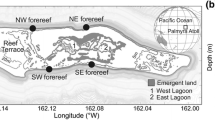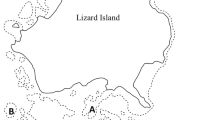Abstract
Tisler Reef is a Norwegian cold-water coral reef in the Northeastern Skagerrak, which lies at an average depth of 120 m, is constructed principally of the scleractinian coral Lophelia pertusa and hosts a dynamic and diverse ecosystem. The availability of oxygen within Tisler Reef, recorded between 2006 and 2008, showed a decline during the summer months, caused by both the isolation of the reef from the atmosphere under conditions of seasonal stratification, and the enhanced respiration in the water column during the seasonal zooplankton proliferations. Concentrations of dissolved oxygen were replenished from high-current flows advecting water from off the reef. Low current flow conditions (< 0.05 m s−1) coincided with a short-term reduction in oxygen, the extent of which varied seasonally and were observed to be greatest during July and August, coinciding with the summer Calanus proliferation in the Skagerrak. Normalized acoustic backscatter amplitude during the summer months showed a strong signal of zooplankton diurnal vertical migration, coinciding with the lowest oxygen concentrations at the reef observed during, and lagging slightly after, the deep phase of the zooplankton vertical migration. This effect was most obvious during low-flow conditions; highlighting the importance of zooplankton and associated activity as a consumer of oxygen at the reef.








Similar content being viewed by others
References
Aure J, Dahl E (1994) Oxygen, nutrients, carbon and water exchange in the Skagerrak Basin. Cont Shelf Res 14:965–977
Bamstedt U (2000) Life cycle, seasonal vertical distribution and feeding of Calanus finmarchicus in Skagerrak coastal water. Mar Biol 137:279–289
Bez N, Rivoirard J (2001) Transitive geostatistics to characterise spatial aggregations with diffuse limits: an application on mackerel ichtyoplankton. Fish Res 50:41–58
Cottier FR, Tarling GA, Wold A, Falk-Petersen S (2006) Unsynchronized and synchronized vertical migration of zooplankton in a high arctic fjord. Limnol Oceanogr 51:2586–2599
Dahlgren TG, Wiklund H, Kallstrom B, Lundälv T, Smith CR, Glover AG (2006) A shallow-water whale-fall experiment in the north Atlantic. Cah Biol Mar 47:385–389
Davies AJ, Guinotte JM (2011) Global Habitat Suitability for Framework-Forming Cold-Water Corals. Plos One 6(1–15):e18483
Davies AJ, Wisshak M, Orr JC, Roberts JM (2008) Predicting suitable habitat for the cold-water coral Lophelia pertusa (Scleractinia). Deep-Sea Res Pt I 55:1048–1062
de Mol B, van Rensbergen P, Pillen S, van Herreweghe K, van Rooij D, McDonnell A, Huvenne V, Ivanov M, Swennen R, Henriet J (2002) Large deep-water coral banks in the Porcupine Basin, southwest of Ireland. Mar Geol 188:193–231
Deines K (1999) Backscatter estimation using broadband acoustic Doppler Current Profilers. Proceedings of the Ieee Sixth Working Conference on Current Measurement 249–253
Dodds LA, Roberts JM, Taylor AC, Marubini F (2007) Metabolic tolerance of the cold-water coral Lophelia pertusa (Scleractinia) to temperature and dissolved oxygen change. J Exp Mar Biol Ecol 349:205–214
Duineveld G, Lavaleye M, Berghuis EM (2004) Particle flux and food supply to a seamount cold-water coral community (Galicia Bank, NW Spain). Mar Ecol Prog Ser 277:13–23
Etnoyer P, Morgan LE (2005) Habitat-forming deep-sea corals in the Northeast Pacific Ocean. In: Freiwald A, Roberts JM (eds) Cold-Water Corals and Ecosystems. Springer, Berlin
Fink HG, Wienberg C, Hebbeln D, McGregor HV, Schmiedl G, Taviani M, Freiwald A (2012) Oxygen control on Holocene cold-water coral development in the eastern Mediterranean Sea. Deep-Sea Res Pt I 62:89–96
Fossa J, Mortensen P, Furevik D (2002) The deep-water coral Lophelia pertusa in Norwegian waters: distribution and fishery impacts. Hydrobiologia 471:1–12
Freiwald A, Fosså J, Grehan A, Koslow T (2004) Cold-water coral reefs. UNEPWCMC
Galkiewicz JP, Pratte ZA, Gray MA, Kellogg CA (2011) Characterization of culturable bacteria isolated from the cold-water coral Lophelia pertusa. FEMS Microbiol Ecol 77:333–346
Gass SE, Roberts JM (2006) The occurrence of the cold-water coral Lophelia pertusa (Scleractinia) on oil and gas platforms in the North Sea: Colony growth, recruitment and environmental controls on distribution. Mar Poll Bull 52:549–559
Guihen D, White M, Lundälv T (2012) Temperature shocks and ecological implications at a cold-water coral reef. Mar Biodivers Rec 5:385
Guihen D, White M, Lundälv T (2013) Boundary layer flow dynamics at a cold-water coral reef. J Sea Res 78:36–44
Hauss H, Christiansen S, Schütte F, Kiko R, Lima ME, Rodrigues E, Karstensen J, Löscher CR, Kortzinger A, Fiedler B (2016) Dead zone or oasis in the open ocean? Zooplankton distribution and migration in low-oxygen modewater eddies. Biogeosciences 13:1977–1989
Huvenne VAI, Masson DG, Wheeler AJ (2009) Sediment dynamics of a sandy contourite: the sedimentary context of the Darwin cold-water coral mounds, Northern Rockall Trough. Int J Earth Sci 98:865–884
Kaartvedt S (2000) Life history of Calanus finmarchicus in the Norwegian Sea in relation to planktivorous fish. Ices J Mar Sci 57:1819–1824
Kaartvedt S (2010) Chapter Nine - Diel Vertical migration behaviour of the Northern Krill (Meganyctiphanes norvegica Sars). In: Tarling G.A. (eds) Advances in Marine Biology. Academic Press, pp 255–275
Kiriakoulakis K, Bett BJ, White M, Wolff GA (2004) Organic biogeochemistry of the Darwin Mounds, a deep-water coral ecosystem, of the NE Atlantic. Deep-Sea Res Pt I 51:1937–1954
Lavaleye M, Duineveld G, Lundälv T, White M, Guihen D, Kiriakoulakis K, Wolff GA (2009) Cold-Water Corals on the Tisler Reef Preliminary Observations on the Dynamic Reef Environment. Oceanog 22:76–84
Leiknes Ø, Striberny A, Tokle NE, Olsen Y, Vadstein O, Sommer U (2014) Feeding selectivity of Calanus finmarchicus in the Trondheimsfjord. J Sea Res 85:292–299
Linnaeus C (1758) Systema naturae : Appendices zoologicae. Edition XII. Hagae Comitis : W. Junk, 1935
Maar M, Nielsen T, Richardson K, Christaki U, Hansen O, Zervoudaki S, Christou E (2002) Spatial and temporal variability of food web structure during the spring bloom in the Skagerrak. Mar Ecol Prog Ser 239:11–29
Maclennan DN, Fernandes PG, Dalen J (2002) A consistent approach to definitions and symbols in fisheries acoustics. Ices J Mar Sci 59:365–369
Middelburg JJ, Mueller CE, Veuger B, Larsson AI, Form A, van Oevelen D (2015) Discovery of symbiotic nitrogen fixation and chemoautotrophy in cold-water corals. Sci Rep 5:17962
Mienis F, de Stigter HC, White M, Dulneveldc G, de Haas H, van Weering TCE (2007) Hydrodynamic controls on cold-water coral growth and carbonate-mound development at the SW and SE rockall trough margin, NE Atlantic ocean. Deep-Sea Res Pt I 54:1655–1674
Mohn C, Rengstorf A, White M, Duineveld G, Mienis F, Soetaert K, Grehan A (2014) Linking benthic hydrodynamics and cold-water coral occurrences: A high-resolution model study at three cold-water coral provinces in the NE Atlantic. Prog Oceanogr 122:92–104
Naumann MS, Orejas C, Wild C, Ferrier-Pagès C (2011) First evidence for zooplankton feeding sustaining key physiological processes in a scleractinian cold-water coral. J Exp Biol 214:3570–3576
Pingree RD, Holligan PM, Mardell GT, Harris RP (1982) Vertical distribution of plankton in the skagerrak in relation to doming of the seasonal thermocline. Cont Shelf Res 1:209–219
Purser A, Larsson AI, Thomsen L, van Oevelen D (2010) The influence of flow velocity and food concentration on Lophelia pertusa (Scleractinia) zooplankton capture rates. J Exp Mar Biol Ecol 395:55–62
Roberts J, Wheeler A, Freiwald A (2006) Reefs of the deep: The biology and geology of cold-water coral ecosystems. Science 312:543–547
Roberts JM (2009) Cold-water corals: the biology and geology of deep-sea coral habitats. Cambridge University Press, Cambridge
Ruggeberg A, Dullo C, Dorschel B, Hebbeln D (2007) Environmental changes and growth history of a cold-water carbonate mound (Propeller Mound, Porcupine Seabight). Int J Earth Sci 96:57–72
Tarling GA, Cuzin-Roudy J, Buchholz F (1999) Vertical migration behaviour in the northern krill Meganyctiphanes norvegica is influenced by moult and reproductive processes. Mar Ecol Prog Ser 190:253–262
Teuber L, Kiko R, Séguin F, Auel H (2013) Respiration rates of tropical Atlantic copepods in relation to the oxygen minimum zone. J Exp Mar Biol Ecol 448:28–36
Titschack J, Baum D, De Pol Holz R, Correa ML, Forster N, Flögel S, Hebbeln D, Freiwald A (2015) Aggradation and carbonate accumulation of Holocene Norwegian cold-water coral reefs. Sedimentology 62:1873–1898
van Oevelen D, Duineveld G, Lavaleye M, Mienis F, Soetaert K, Heip C (2009) The cold-water coral community as a hot spot for carbon cycling on continental margins: A food-web analysis from Rockall Bank (northeast Atlantic). Limnol Oceanogr 54:1829–1844
van Oevelen D, Mueller CE, Lundälv T, Middelburg JJ (2016) Food selectivity and processing by the cold-water coral Lophelia pertusa. Biogeosciences 13:5789–5798
Wagner H, Purser A, Thomsen L, Jesus CC, Lundälv T (2011) Particulate organic matter fluxes and hydrodynamics at the Tisler cold-water coral reef. J Marine Syst 85:19–29
Wheeler AJ, Beyer A, Freiwald A, de Haas H, Huvenne VAI, Kozachenko M, Roy KO-L, Opderbecke J (2006) Morphology and environment of cold-water coral carbonate mounds on the NW European margin. Int J Earth Sci 96:37–56
Wheeler AJ, Kozachenko M, Masson DG, Huvenne VAI (2008) Influence of benthic sediment transport on cold-water coral bank morphology and growth: the example of the Darwin Mounds, north-east Atlantic. Sedimentology 55:1875–1887
White M (2007) Benthic dynamics at the carbonate mound regions of the Porcupine Sea Bight continental margin. Int J Earth Sci 96:1–9
White M, Wolff GA, Lundälv T, Guihen D, Kiriakoulakis K, Lavaleye M, Duineveld G (2012) Cold-water coral ecosystem (Tisler Reef, Norwegian Shelf) may be a hotspot for carbon cycling. Mar Ecol Prog Ser 465:11–23
Wienberg C, Titschack J, Freiwald A, Frank N, Lundaelv T, Taviani M, Beuck L, Schroeder-Ritzrau A, Krengel T, Hebbeln D (2018) The giant Mauritanian cold-water coral mound province: Oxygen control on coral mound formation. Quaternary Science Reviews 185:135–152
Wilson CB (1932) Copepods of the Woods Hole region, Massachusetts. U.S. Nat. Hist. Mus. 158:635–676
Wisshak M, Freiwald A, Lundalv T, Gektidis M (2005) The physical niche of the bathyal Lophelia pertusa in a non-bathyal setting: environmental controls and palaeoecological implications. Erlangan Earth Conf 979–1001
Yesson C, Taylor ML, Tittensor DP, Davies AJ, Guinotte J, Baco A, Black J, Hall-Spencer JM, Rogers AD (2012) Global habitat suitability of cold-water octocorals. J Biogeogr 39:1278–1292
Acknowledgements
The authors wish to thank the staff of the Sven Lovén Centre for Marine Sciences, Tjärnö, Univeristy of Göteborg. This research has received funding from the European Community’s Seventh Framework Programme (FP7/2007-2013) under the HERMIONE project, grant agreement No 226354, and by the HERMES project, EC contract GOCE-CT-2005-511234). This research was supported under Australian Research Council’s Special Research Initiative for Antarctic Gateway Partnership (Project ID SR140300001).
Author information
Authors and Affiliations
Corresponding author
Ethics declarations
Conflict of interest
On behalf of all authors, the corresponding author states that there is no conflict of interest.
Additional information
Topical Editors Eberhard Gischler
Rights and permissions
About this article
Cite this article
Guihen, D., White, M. & Lundälv, T. Zooplankton drive diurnal changes in oxygen concentration at Tisler cold-water coral reef. Coral Reefs 37, 1013–1025 (2018). https://doi.org/10.1007/s00338-018-1711-0
Received:
Accepted:
Published:
Issue Date:
DOI: https://doi.org/10.1007/s00338-018-1711-0




